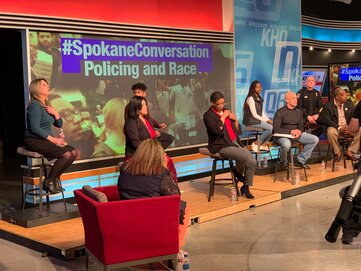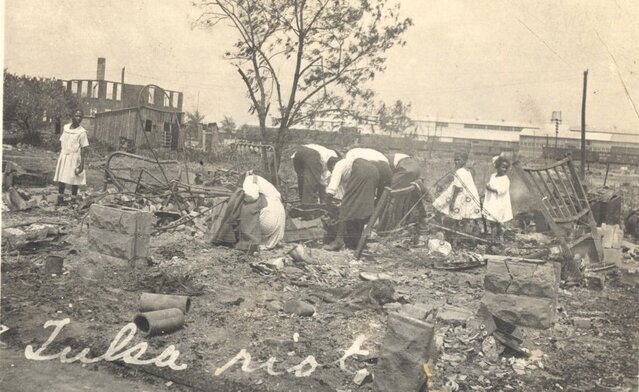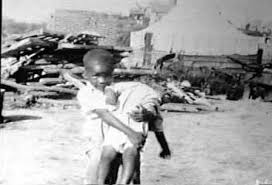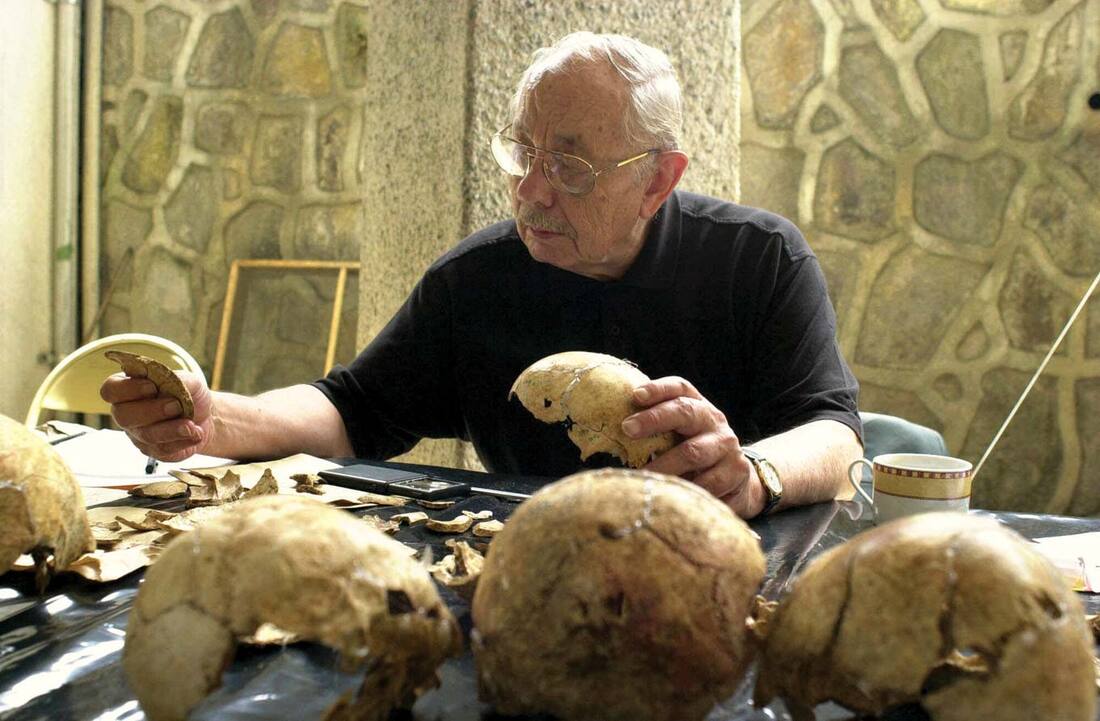|
This week we had a community conversation about race and policing in my city, Spokane, Washington. I have a couple take-aways. Our mayor and police chief are nice people. But as blacks on the panel spoke about the dangers of living-while-black in Spokane, city leaders spoke about what they've been doing to improve the situation and how, yes, they need to increase those efforts.  Photo courtesy KHQ News Photo courtesy KHQ News They showed no understanding of the need for structural change. They showed no understanding of white privilege. One point brought up several times by the local leader of the NAACP, is the need to understand our history. To create structural change and a just future, we need to be clear about our past. I jumped right on that. You know I believe this. That is a huge part of why I write this blog. One city that demonstrates this need to recognize that history matters and why structural change is needed: Tulsa, Oklahoma. If you've heard of the 1921 "race riot" in Tulsa, wipe your mind clear. It was a massacre. Human Rights Watch released a 66 page document this past week demanding reparations for survivors and descendants of those caught in the 48-hour reign of terror in Tulsa. Reign of Terror In segregated, Jim Crow Tulsa, the Greenwood district, known as "Little Africa" grew into one of the most economically vibrant black communities in the U.S. Thriving businesses lined its streets: banks, movie theaters, hotels, beauty shops, grocery stores, restaurants, as well as the offices of lawyers, realtors, doctors and other professionals. Known across across the country, as "Negro Wall Street", the entire 35-square blocks including more than 12-thousand homes burned to ashes in two days, May 31-June 1, 1921. An estimated 300 black people were killed.  The murder and devastation was deliberate, sparked by accusations that a black man assaulted a white woman. According to witnesses, white mobs looted black homes and businesses before setting them ablaze. “They tried to kill all the black folks they could see,” survivor George Monroe, recalled. Law enforcement did nothing to stop the violence. In fact, witnesses say some officers participated in the looting and killing, including members of the Oklahoma National Guard. Survivors told of seeing black bodies dumped into the Arkansas River and disposed of in mass graves. “Many of the survivors mentioned bodies were stacked like cord wood,” says Richard Warner of the Tulsa Historical Society.  The fires left 10,000 homeless, subsisting in tents provided by the Red Cross. Incredibly, the black community of Greenwood regrouped, rebuilt, and restored their neighborhood by 1938. That despite the fact that insurance companies refused to compensate home owners and business for their losses. Not a single person was ever held responsible for the murders and property damage. White Tulsans chose to pretend it never happened, actively suppressing the truth. Even privately, they did not speak of it. Newspapers of the time grossly under-reported the death tally, claiming 36 blacks died. Textbooks omitted this history completely. Then after 77 years, evidence of the massacre started to surface. The Oklahoma Legislature appointed a commission to establish an historical record of the event. The commission brought in an expert to investigate possible sites where black bodies might have been buried. Clyde Snow liked to say bones make good witnesses, never forgetting and never lying. Before his death in 2014, Clyde Snow was one of the world's foremost forensic anthropologists. He helped identify the remains of Nazi war criminal Josef Mengele and confirmed the identification of President John F. Kennedy after his assassination. He aided in the determination that more than 200 victims found in a mass grave in Yugoslavia had been killed in an execution style of ethnic cleansing. In Tulsa, Snow investigated ground that had been a potters field in 1921. It was the suspected site of a mass grave where black bodies might have been buried after the massacre. Using ground-penetrating radar, the forensic anthropologist discovered an aberration in the earth, which the commission report stated "all the characteristics of a dug pit or trench with vertical walls and an undefined object within the approximate center of the feature." In addition, a witness came forward, a white man named Clyde Eddy who'd been 10 at the time of the massacre. Eddy remembered seeing men dig a trench and prepare to bury wooden crates containing remains of black victims. Clyde Snow drew parallels between the violence in Tulsa and state-sponsored killings he investigated in other countries. The commission's evidence led him to believe the so-called Tulsa "riot" was an act of ethnic cleansing facilitated by the Oklahoma National Guard. In 2000, the Tulsa Race Riot Commission made a number of recommendations for moving forward, including further investigation of possible mass grave sites and cash reparations to survivors (149 were alive at the time) and descendants of those killed and of survivors. The only action taken was by the State of Oklahoma which issued survivors decorative medals. Now, twenty years later it's possible Tulsa can begin to address its racist history. This last December archaeologists discovered further evidence of possible mass graves at two sites in the city. Excavations were to have started in February, but have been postponed due to COVID-19.  Child survivor of 1921 Tulsa Massacre Child survivor of 1921 Tulsa Massacre And coincidentally with nationwide "Black Lives Matter" protests, Human Rights Watch issued a news call for reparations for blacks in Tulsa. Human Rights Watch is a non-governmental organization that conducts research and advocacy on human rights around the world. “No one has ever been held responsible for these crimes, the impacts of which black Tulsans still feel today,” says the report, titled “The Case for Reparations in Tulsa, Oklahoma: A Human Rights Argument.” “Efforts to secure justice in the courts have failed due to the statute of limitations. Ongoing racial segregation, discriminatory policies, and structural racism have left black Tulsans, particularly those living in North Tulsa, with a lower quality of life and fewer opportunities.” The community has higher rates of poverty and police brutality. Black Tulsans are subjected to physical force by police — tasers, police dog bites, pepper spray, punches, and kicks — 2.7 times more than whites, according to Human Rights Watch. Today, the area once known as Black Wall Street is marked by a mural painted on the side of Interstate 244, which bisected the neighborhood in 1970. While traffic roars through on the interstate, gentrification creeps into Greenwood. There's a minor-league baseball stadium, an arts district marketed to millennials, and a high-end apartment complex with a yoga studio and pub. City Councilor Vanessa Hall-Harper says gentrification of the neighborhood is driven by the same greed that fed the fire of white violence 100 years ago.  "There was economic jealously that caused them to destroy Greenwood...The stadium is like building a Whole Foods at the site of the Oklahoma City bombing." "This is sacred ground," Hall-Harper said. "As developers are making decisions about the Greenwood district, the history is being ignored, and I think it is intentional. They want to forget about it and move on." Not only forget, but whitewash. Near the baseball stadium's entrance, the mural is signed "Tulsa Race Riot 1921." Someone has crossed out "riot" and written "massacre." Someone else has crossed out "massacre" and left a scribble of black spray paint.  livia Hooker, the last known survivor of the 1921 racist attack in Tulsa, died two years ago at 103. She was six 6 when the violence erupted, but never forgot how her mother told her and her three siblings to hide under their dining room table. "She said, 'Keep quiet, and they won't know you are under here.' The [whites who came in her house] took everything they thought was valuable. They smashed everything they couldn't take," Hooker said. This past week, Oklahoma offered a panel discussion on race, facilitated by Governor Kevin Stitts and his wife. Black leaders criticized the governor for stacking the panel with folks who would not challenge him on his racial beliefs and biases, calling the event a "superficial show of solidarity." Two of the four panelists were law enforcement officers. There were no women, no Latinx or indigenous Oklahomans, no millennials, and no recognizable black activists or leaders from social justice groups. At the panel in Spokane, the police chief made a point of saying his officers are good, caring people, and that George Floyd was killed in Minneapolis, not here.
What he fails to understand is that "good" isn't good enough. Being "not guilty" of killing a black man is not good enough. Claiming not to be a racist is not enough. That's why we're hearing the term anti-racist. Being anti-racist requires recognition of the privilege bestowed on us simply because we were born with white skin, reckoning with the fact that racism is systemic and taking action. We can't sit on one side of the scale of justice and expect it to level on it's own. We must involve ourselves intentionally in day-to-day efforts to dismantle the racist structures in our schools, our cities and our country. If not engaging, we are automatically, by default, perpetuating the problem. Sources: https://thislandpress.com/2011/06/11/what-lies-beneath/ https://abcnews.go.com/US/tulsa-marks-grim-anniversary-1921-race-massacre-protests/story?id=71010791 https://ktul.com/news/local/tulsas-dark-secret-the-mass-graves-of-the-1921-race-riot https://theblackwallsttimes.com/2020/06/08/bwstimes-gives-gov-kevin-stitt-2-out-of-10-on-race-conversation/ https://www.sapiens.org/news/tulsa-race-massacre/ https://www.hrw.org/news/2019/09/12/us-how-abusive-biased-policing-destroys-lives https://www.washingtonpost.com/local/tulsa-mayor-reopens-investigation-into-possible-mass-graves-from-1921-race-massacre/2018/10/02/df713c96-c68f-11e8-b2b5-79270f9cce17_story.html Comments are closed.
|
I'm fascinated to discover little-known history, stories of people and events that provide a new perspective on why and how things happened, new voices that haven't been heard, insight into how the past brought us here today, and how it might guide us to a better future.
I also post here about my books and feature other authors and their books on compelling and important historical topics. Occasionally, I share what makes me happy, pictures of my garden, recipes I've made, events I've attended, people I've met. I'm always happy to hear from readers in the blog comments, by email or social media. Archives
September 2023
Categories
All
|






